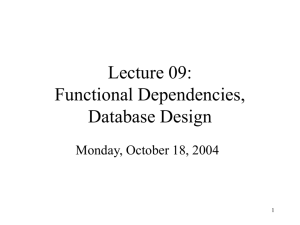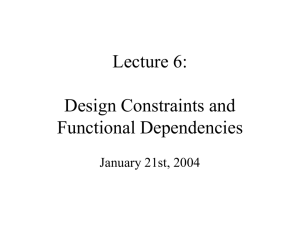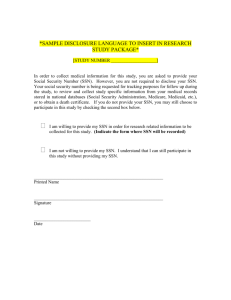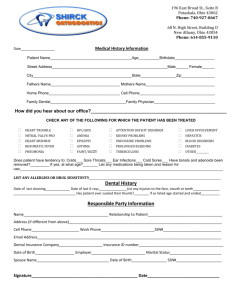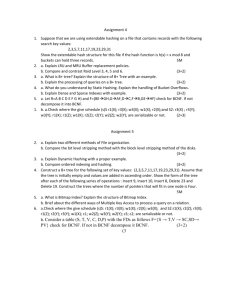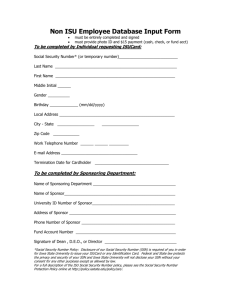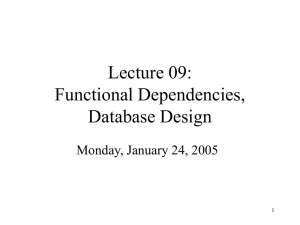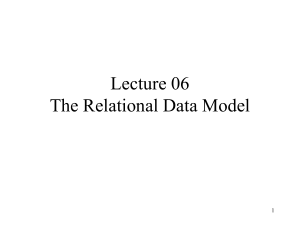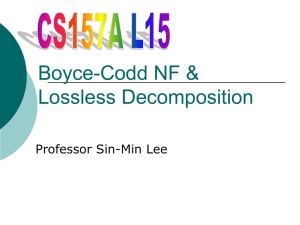Functional Dependencies & Relational Decomposition
advertisement
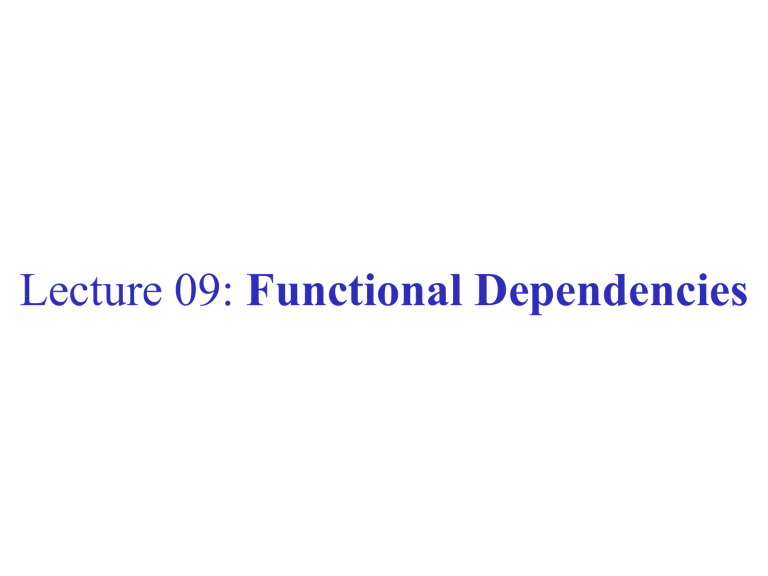
Lecture 09: Functional Dependencies
Outline
• Functional dependencies (3.4)
• Rules about FDs (3.5)
• Design of a Relational schema (3.6)
Relational Schema Design
name
Conceptual Model:
Product
buys
Person
price
date
Relational Model:
plus FD’s
Normalization:
Eliminates anomalies
name
ssn
Functional Dependencies
Definition: A1, ..., Am → B1, ..., Bn holds in R if:
t, t’ R, (t.A1=t’.A1 ... t.Am=t’.Am t.B1=t’.B1 ... t.Bm=t’.Bm )
R
A1
...
Am
B1
...
Bm
t
t’
if t, t’ agree here
then t, t’ agree here
Important Point!
• Functional dependencies are part of the
schema!
• They constrain the possible legal data
instances.
• At any point in time, the actual database
may satisfy additional FD’s.
Examples
EmpID
Name
Phone
Position
E0045
John Smith
2376
HR
E1847
Zheng Li
2376
QA
E3123
Lucy Larsen
1264
Developer
E9923
Zheng Li
1264
Developer
• EmpID → Name, Phone, Position
• Position → Phone
• but Phone → Position
Formal definition of a key
• A key is a set of attributes A1, ..., An s.t. for
any other attribute B,
A1, ..., An → B
• A minimal key is a set of attributes which
is a key and for which no subset is a key
• Note: book calls them superkey and key
Examples of Keys
• Product(name, price, category, color)
name, category → price
category → color
Keys are: {name, category} and all supersets
• Enrollment(student, address, course, room, time)
student → address
room, time → course
student, course → room, time
Keys are: [in class]
Inference Rules for FD’s
A1 , A2 , … An→B1, B2, … Bm
Splitting rule
and
Combing rule
Is equivalent to
A1 , A2 , … An →B1
AND
A1 , A2 , … An →B2
…
A1 , A2 , … An →Bm
A1
...
Am
B1
...
Bm
Inference Rules for FD’s
(continued)
A1 , A2 , … An → Ai
Trivial Rule
where i = 1, 2, ..., n
A1
Why ?
...
Am
Inference Rules for FD’s
(continued)
Transitive Closure Rule
If
A1 , A2 , … An → B1, B2, … Bm
and
B1, B2, … Bm → C1 , C2 , … Ck
then
A1 , A2 , … An → C1 , C2 , … Ck
Why?
A1
...
Am
B1
...
Bm
C1
...
Ck
• Enrollment(student, major, course, room, time)
student → major
major, course → room
course → time
What else can we infer ? [in class]
Closure of a set of Attributes
Given a set of attributes {A1, …, An} and a set of dependencies S.
Problem: find all attributes B such that:
any relation which satisfies S also satisfies:
A1 , A2 , … An → B
The closure of {A1, …, An}, denoted {A1, …, An}+,
is the set of all such attributes B
Closure Algorithm
Start with X={A1, …, An}.
Until X doesn’t change do:
if B1, B2, … Bm → C is in S, and
B1, B2, … Bm are all in X and
C is not in X
then
add C to X
Example
The schema - R(A,B,C,D,E,F)
A, B
A,D
B
A,F
→
→
→
→
C
E
D
B
Closure of {A,B}:
X = {A, B,
}
Closure of {A, F}:
X = {A, F,
}
Why Is the Algorithm Correct ?
• Show the following by induction:
– For every B in X:
• A1 , A2 , … An → B
• Initially X = {A1 , A2 , … An } holds
• Induction step: B1, …, Bm in X
– Implies A1 , A2 , … An → B1, B2, … Bm
– We also have B1, B2, … Bm → C
– By transitivity we have A1 , A2 , … An → C
• This shows that the algorithm is sound; need to
show it is complete
Relational Schema Design
(or Logical Design)
Main idea:
• Start with some relational schema
• Find out its FD’s
• Use them to design a better relational
schema
Relational Schema Design
Recall set attributes (persons with several phones):
Name
SSN
PhoneNumber City
Fred
123-45-6789
206-555-1234 Seattle
Fred
123-45-6789
206-555-6543 Seattle
Joe
987-65-4321
908-555-2121 Westfield
Joe
987-65-4321
908-555-1234 Westfield
SSN → Name, City, but not SSN → PhoneNumber
Anomalies:
• Redundancy
= repeated data
• Update anomalies = Fred moves to “Bellevue”
• Deletion anomalies = Fred drops all phone numbers:
what is his city ?
Relation Decomposition
Break the relation into two:
Name
SSN
City
Fred
123-45-6789
Seattle
Joe
987-65-4321
Westfield
SSN
PhoneNumber
123-45-6789
206-555-1234
123-45-6789
206-555-6543
987-65-4321
908-555-2121
987-65-4321
908-555-1234
Relational Schema Design
name
Conceptual Model:
Product
buys
Person
price
date
Relational Model:
plus FD’s
Normalization:
Eliminates anomalies
name
ssn
Decompositions in General
R(A1, ..., An)
Create two relations R1(B1, ..., Bm) and R2(C1, ..., Ck)
such that: B1, ..., Bm C1, ..., Ck = A1, ..., An
and:
R1 = projection of R on B1, ..., Bm
R2 = projection of R on C1, ..., Ck
Incorrect Decomposition
• Sometimes it is incorrect:
Name
Price
Category
Gizmo
19.99
Gadget
OneClick
24.99
Camera
DoubleClick
29.99
Camera
Decompose on : Name, Category and Price, Category
Incorrect Decomposition
Name
Category
Price
Category
Gizmo
Gadget
19.99
Gadget
OneClick
Camera
24.99
Camera
DoubleClick
Camera
29.99
Camera
When we put it back:
Cannot recover information
Name
Price
Category
Gizmo
19.99
Gadget
OneClick
24.99
Camera
OneClick
29.99
Camera
DoubleClick
24.99
Camera
DoubleClick
29.99
Camera
Normal Forms
First Normal Form = all attributes are atomic
Second Normal Form (2NF) = old and obsolete
Third Normal Form (3NF) = this lecture
Boyce Codd Normal Form (BCNF) = this lecture
Others...
Boyce-Codd Normal Form
A simple condition for removing anomalies from relations:
A relation R is in BCNF if:
Whenever there is a nontrivial dependency A1, ..., An → B
in R , {A1, ..., An} is a key for R
Including
superkeys
Whenever a set of attributes of R determines one more attribute,
it should determine all the attributes of R.
In English:
Example
Name
SSN
PhoneNumber City
Fred
123-45-6789
206-555-1234 Seattle
Fred
123-45-6789
206-555-6543 Seattle
Joe
987-65-4321
908-555-2121 Westfield
Joe
987-65-4321
908-555-1234 Westfield
What are the dependencies?
SSN → Name, City
What are the keys?
{SSN, PhoneNumber}
Is it in BCNF?
Decompose it into BCNF
Name
SSN
City
Fred
123-45-6789
Seattle
Joe
987-65-4321
Westfield
SSN
PhoneNumber
123-45-6789
206-555-1234
123-45-6789
206-555-6543
987-65-4321
908-555-2121
987-65-4321
908-555-1234
SSN → Name, City
Summary of BCNF
Decomposition
Find a dependency that violates the BCNF condition:
A1 , A2 , … An → B1, B2, … Bm
Heuristics: choose B1, B2, … Bm “as large as possible”
Decompose:
Exercise: Is
there a 2attribute relation
that is not in
BCNF ?
Others
R1
A’s
B’s
R2
Continue until
there are no
BCNF violations
left.
Example Decomposition
Person(name, SSN, age, hairColor, phoneNumber)
SSN → name, age
age → hairColor
Decompose in BCNF (in class):
Step 1: find all keys
Step 2: now decompose
Other Example
• R(A,B,C,D) A → B, B → C
• Key: A, D
• Violations of BCNF: A → B, B → C, A → C,
A → B,C
• Pick A → B,C:
split R into R1(A,B,C), R2(A,D)
• What happens if we pick A → B first ?
Correct Decompositions
A decomposition is lossless if we can recover:
R(A,B,C)
Decompose
R1(A,B)
R2(A,C)
Recover
R’(A,B,C) should be the same as
R(A,B,C)
R’ is in general larger than R. Must ensure R’ = R
Correct Decompositions
• Given R(A,B,C) s.t. A→B, the
decomposition into R1(A,B), R2(A,C) is
lossless
3NF: A Problem with BCNF
Film
Actor
Character
FD’s: Character Film;
Film, Actor Character
So, there is a BCNF violation, and we decompose.
Film
Character
Actor
Character
Character Film
No FDs
So What’s the Problem?
Film
Austin Powers
Austin Powers
Character
Austin Powers
Dr. Evil
Actor
Mike Myers
Mike Myers
Character
Austin Powers
Dr. Evil
No problem so far. All local FD’s are satisfied.
Let’s put all the data back into a single table again:
What
happened
here?
Film
Austin Powers
Actor
Character
Mike Myers Austin Powers
Austin Powers
Mike Myers
Dr. Evil
Violates the dependency: Film, Actor Character!
Solution: 3rd Normal Form
(3NF)
A simple condition for removing anomalies from relations:
A relation R is in 3rd normal form if :
Whenever there is a nontrivial dependency A1, A2, ..., An B
for R , then {A1, A2, ..., An } a key for R,
or B is part of a key.
Including
superkeys
3NF has a dependency-preserving decomposition
Decomposition into 3NF
• Easy when we know BCNF decomposition
(how?)
• Not-so-easy: if we want a dependencypreserving decomposition…
In the book (3.5)
